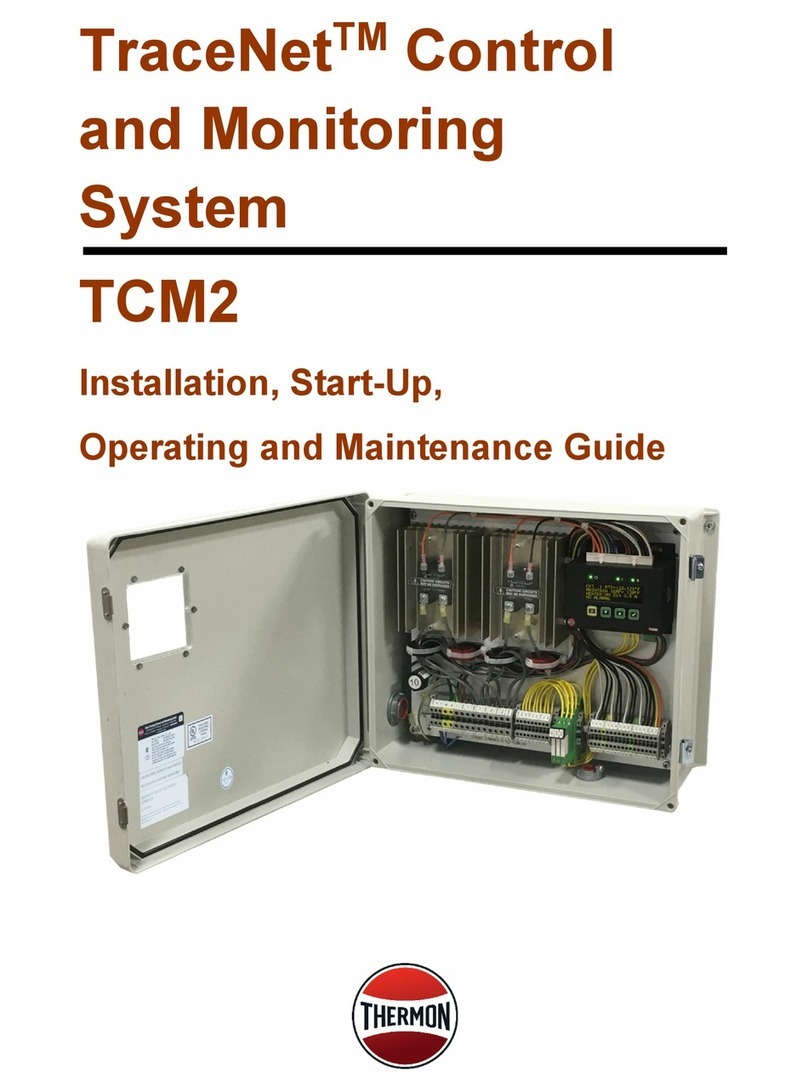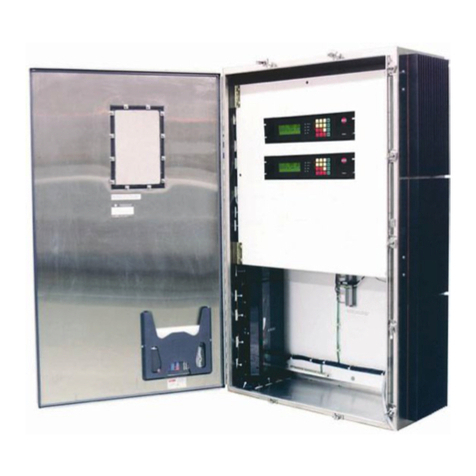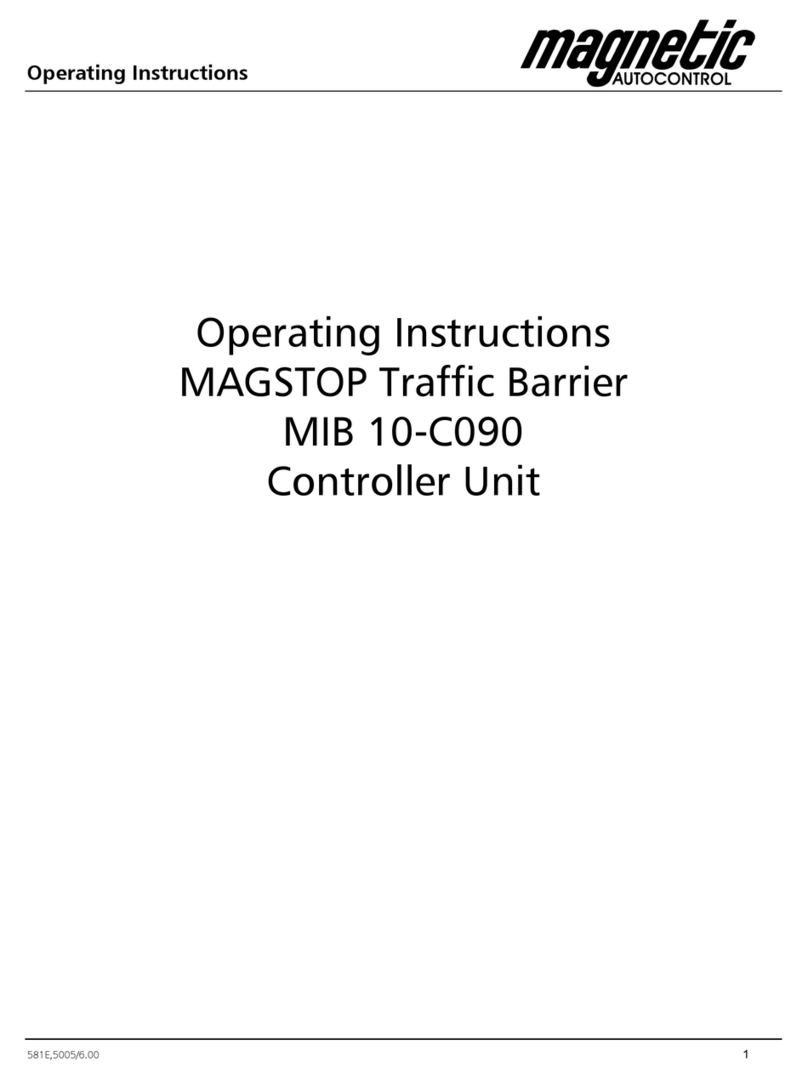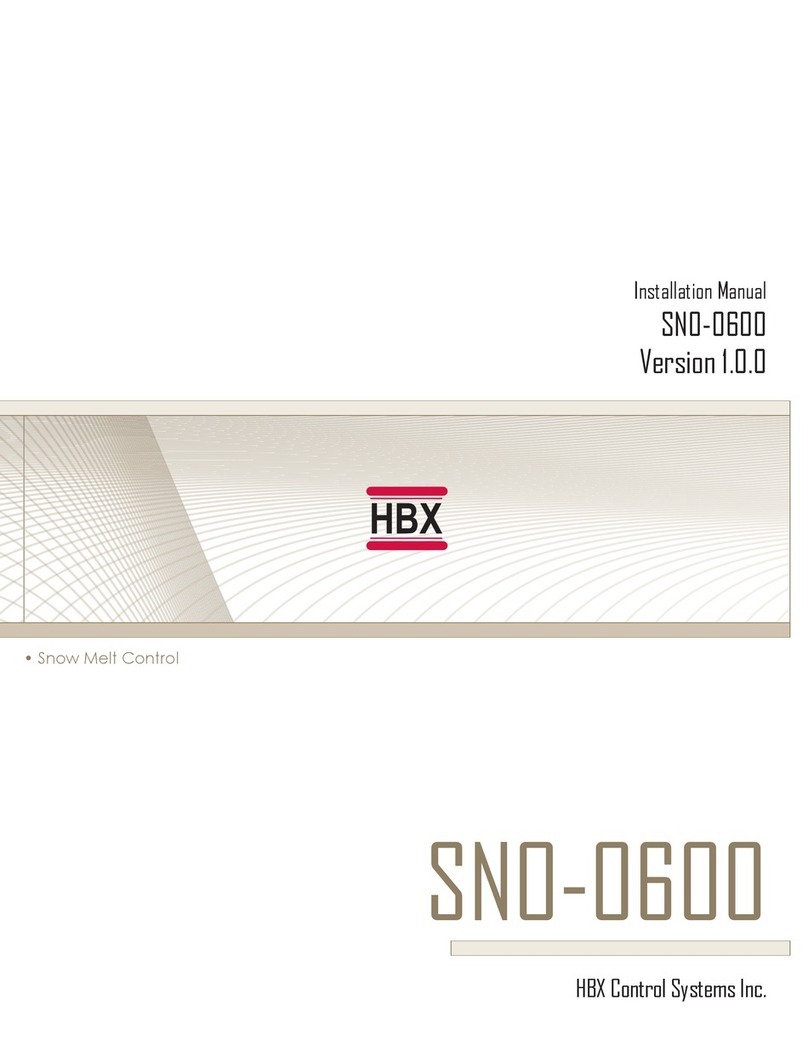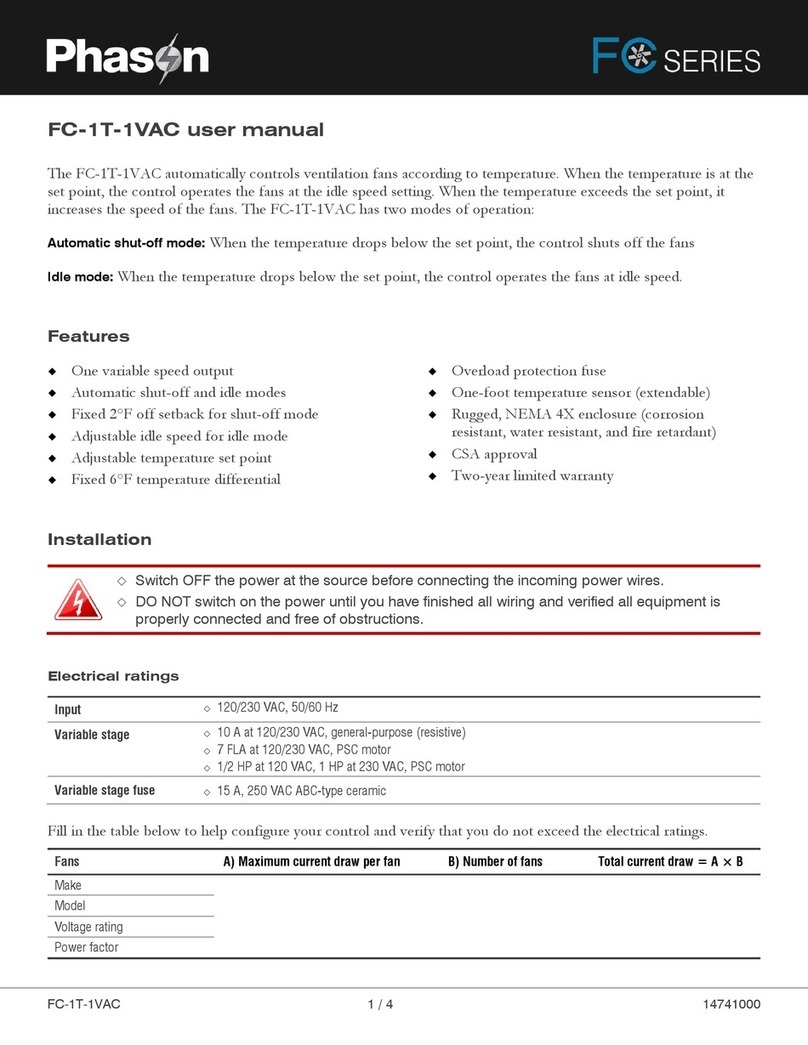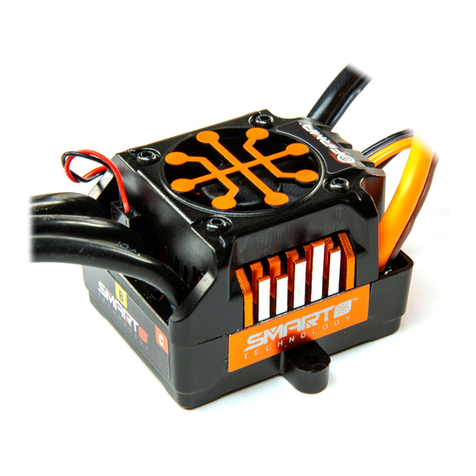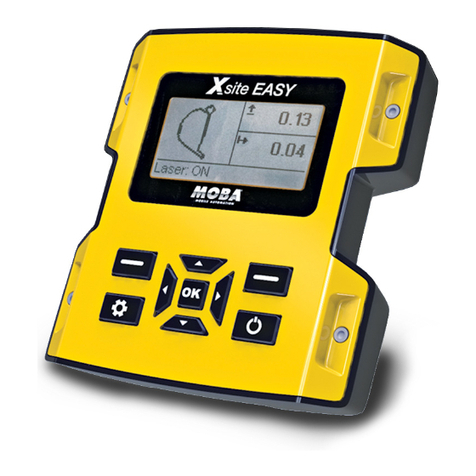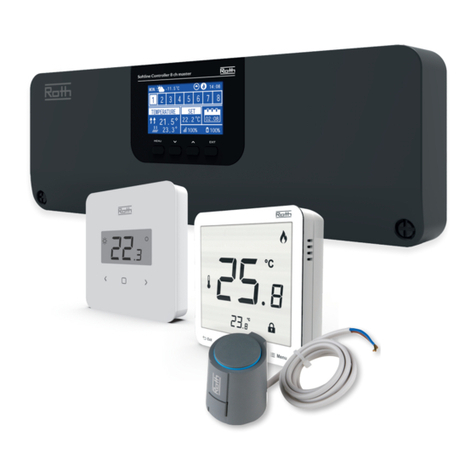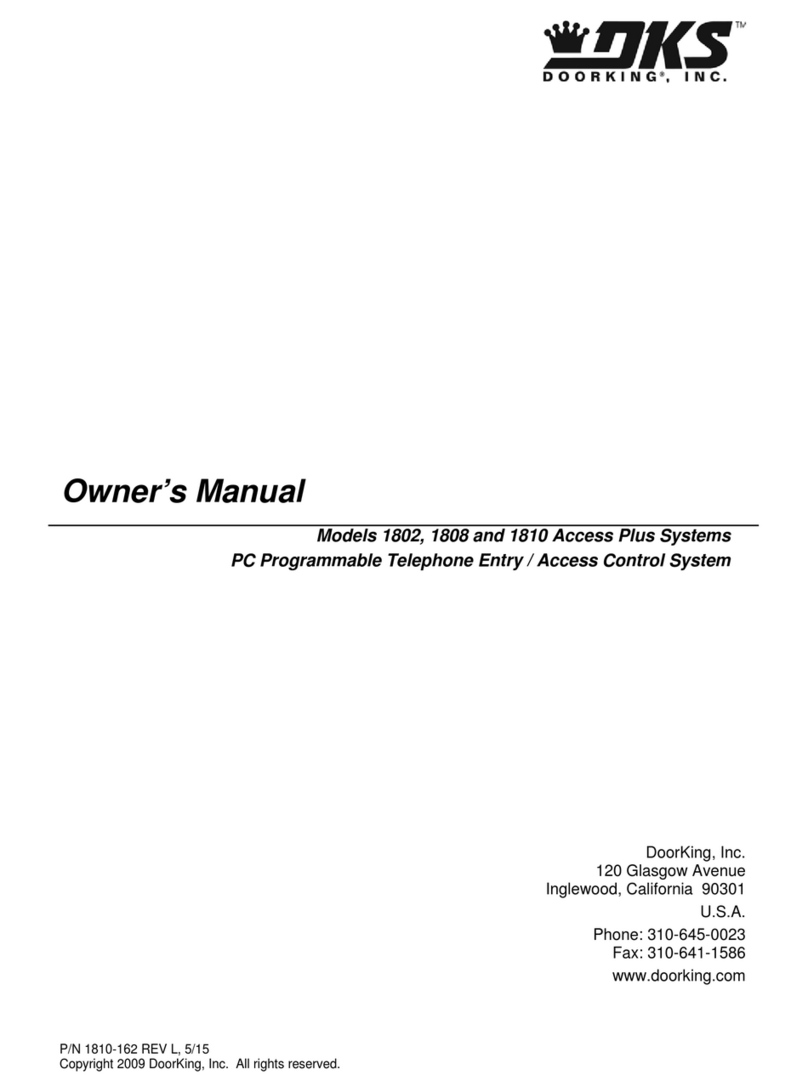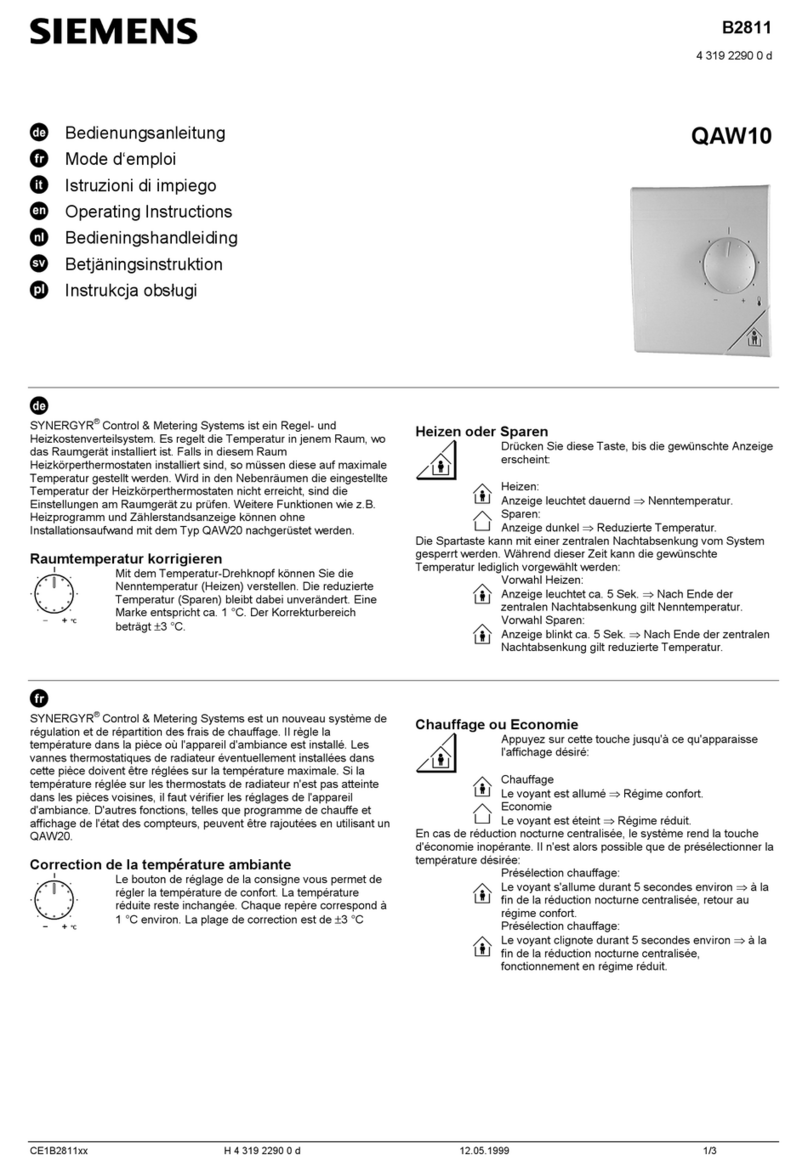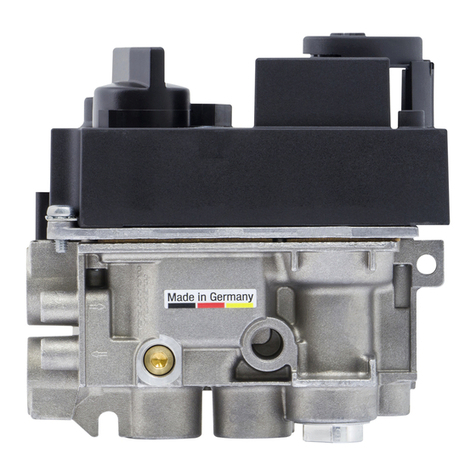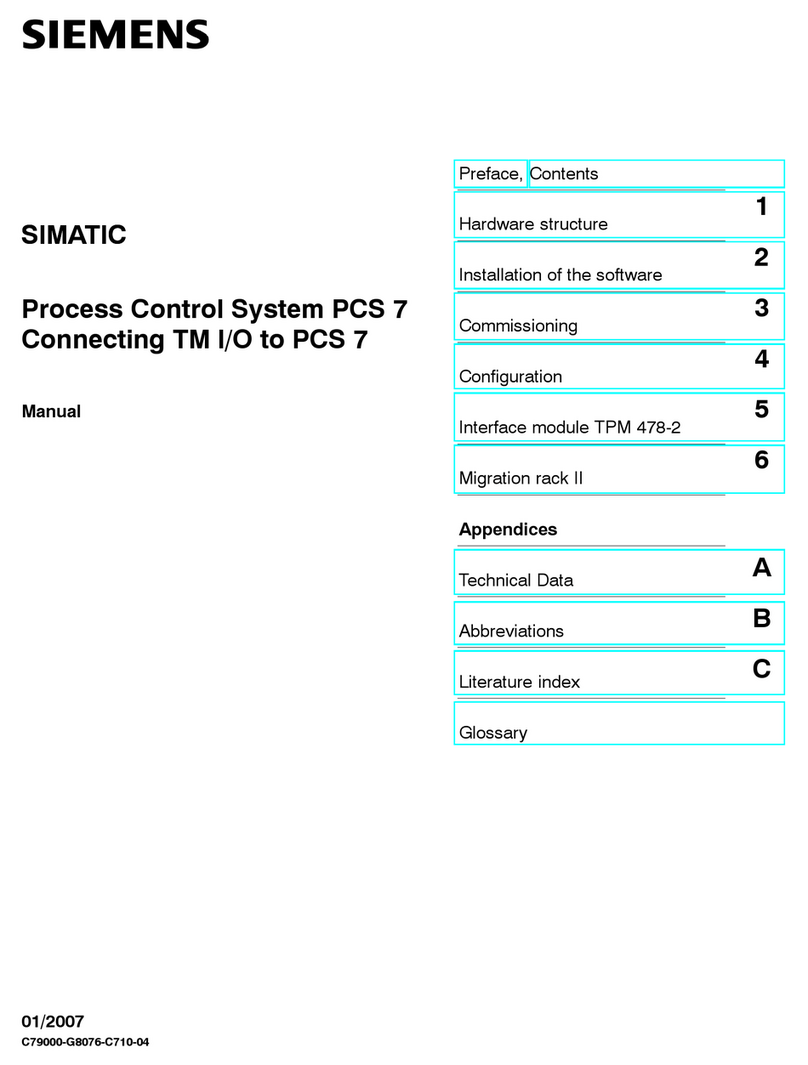Thermon Tracenet Genesis Owner's manual

TRACENETTM GENESIS
CONTROL AND MONITORING SYSTEM
Installaon, Operaon & Maintenance Guide

2
TraceNet Genesis Installaon, Operaon & Maintenance Guide
This guide, as well as the soware and/or rmware described in it, is furnished under license and may only be used or
copied in accordance with the terms of such license. The informaon in this guide is furnished for informaonal use only,
is subject to change without noce, and should not be construed as a commitment by Thermon. Thermon assumes no
responsibility or liability for any errors or inaccuracies that may appear in this guide.
This informaon is subject to change without noce. It is recommended that a quick check of the current revision status
be done at www.thermon.com prior to proceeding.
PRODUCT WARRANTY INFORMATION
The seller warrants all equipment manufactured by it to be free from defects in workmanship or material under normal use and service. If any part
of the equipment proves to be defecve in workmanship or material and if such part is, within 12 months of the date of shipment from sellers
factory, and if the same is found by the seller to be defecve in workmanship or material, it will be replaced or repaired, free of charge, F.O.B. the
seller’s factory. The seller assumes no liability for the use or misuse by the buyer, his employees, or others. A defect within the meaning of this
warranty in any part of any piece of equipment shall not, when such part is capable of being renewed, repaired, or replaced, operate to condemn
such piece of equipment. This warranty is in lieu of all other warranes (including without liming the generality of the foregoing warranes of
merchantability and tness for a parcular purpose), guarantees, obligaons, or liabilies expressed or implied by the seller or its representaves
and by statue or rule of the law.

3
TraceNet Genesis Installaon, Operaon & Maintenance Guide
Table of Contents
Secon 1: Genesis Introducon And Overview ..........................................................................4
Secon 2: Panel Inspecon, Field Connecons And Internal Wiring.........................................4
2.1: Recommended Visual Inspecon Procedures ...............................................................4
2.2: Wiring and Connecons Survey .....................................................................................4
2.3: Control System Operaon Check ...................................................................................4
2.4: Heat Trace and Insulaon Installaon ............................................................................5
2.5: Power Distribuon Wiring and Breakers ........................................................................5
2.6: TraceNet Panel Wiring ....................................................................................................5
Secon 3: The Genesis System—Overview ................................................................................6
3.1: Genesis Modules Overview ............................................................................................6
3.1.1: The HMI Module ......................................................................................................6
3.1.2: The DCM ..................................................................................................................6
3.1.3: The DTM ...................................................................................................................6
3.1.4: The IOM ...................................................................................................................7
3.2: The Genesis HMI Screens ...............................................................................................8
3.3: Seng Addresses and Conguring Genesis DCM and DTM ........................................15
Secon 4: Genesis Control Opons and Examples ..................................................................16
4.1: Line Sensing Control .....................................................................................................16
4.2: Ambient Sensing Opons .............................................................................................16
4.3: Proporonal Control and Power Clamp .......................................................................17
Secon 5: Genesis Tesng and Start-Up ...................................................................................17
Secon 6: Operaon and Maintenance of the Genesis Control and Monitoring System .......17
6.1: Maintenance.................................................................................................................17
6.2: Maintenance Schedule Recommendaon ...................................................................17
Appendix A: Quick Start Guide For The Genesis Control And Monitoring System ..................18
Appendix B: Genesis Specicaons Guide With Component Limits And Specicaons .........20
Appendix C: Troubleshoong Tips For Reliable Electrical Heat Trace Performance ................28
Appendix D: Genesis Modbus Memory Reference ..................................................................34
Appendix E: Recommended Wiring For RS 485 Communicaons ...........................................35
NOTE: The TraceNet Command Communicaons Operang Instrucons are addressed in a separate document
covering TraceNet Genesis, as well as TN, TCM18, TC1818, TCM2, TC202, TC201, TC101, and ECM. TraceNet
Genesis requires TraceNet Command Version 2.3.0+ for operaon.

4
Secon 1: Genesis Introducon and
Overview
The following serves as a general guide and overview on
the installaon, startup, operaon, and maintenance of a
TraceNet Genesis heat tracing control panel. This guide is
to be sent in conjuncon with the project specic panel
drawings and any other installaon instrucons/guides
and standards provided. In the unlikely event that a conict
or uncertainty arises, contact the Thermon engineering
support personnel assigned to this project to clarify.
NOTE: All personnel should be properly trained and
qualied to safely install, service, operate, and program
this TraceNet heat tracing control panel as well as to install,
operate, and maintain all associated heat tracing.
Secon 2: Panel Inspecon, Field
Connecons and Internal Wiring
A typical Genesis Panel may include electrical distribuon
(oponal main breaker with branch breakers for each
electrical heang circuit, either within the Genesis panel
or in an adjacent electrical distribuon enclosure. (Refer to
the project specic drawings for each panel.)
Wide variees of TraceNet Genesis panel conguraons
are possible and can be located in site locaons having
electrically classied areas and/or ordinary locaons. The
actual panel markings provided with the panel will detail
the approvals for the specic locaon of the panel.
2.1: Recommended Visual Inspecon Procedures
• Inspect door and/or solid state heat sink gaskets for
water intrusion as indicated by mineral deposits and
rust. Where feasible replace any gaskets which appear
to be faulty.
• Survey panel exterior and interior for dust, lint, moisture,
or foreign residue. Remove any such residue with a lint
free cloth material. Heavy residues may be addressed
with wood scrapers and a cleaning agent. Do not soak
parts with cleaning agent but only use dampened cloths
in removing heavy residues. Excessive applicaon of
cleaning agents can damage components.
• Check for panel corrosion and scratches. Remove
corrosion and prepare any damaged areas with
sandpaper. Repaint with the approved primer and
touch up paint.
• Check door hinges, latches, and other moving parts
for proper operaon. Use machine oil to lubricate the
moving parts and restore proper operaon where
necessary.
• Check for mechanical damage to any windows as well
as check the window seals. Repair or replace damaged
materials. In all cases where equipment damage is
observed, a root cause analysis should be iniated
to determine any future correcve acon needed to
prevent a recurrence.
2.2: Wiring and Connecons Survey
• The wiring and connecons survey recommended is as
follows:
• If the servicing of removable electrical connectors is
to be conducted, then make certain the area is free of
explosive atmospheres.
• If equipment is available, an infrared scan of the interior
of the panel cabinet and associated wiring (during
operaon) is recommended.
• Any unusually high temperatures at connecons
are usually evidence of poor connecons. Tighten
connecons, repair with new terminaons, and/or
replace any components which have been exposed to
long term overheang. All terminal block connecons
should be ghtened using a torque indicang screw
driver to the levels indicated in Table 1 and project
installaon drawings.
• Check for corrosion at electrical connecons and
terminaons. Where corrosion of electrical terminals
is observed, this may be addional evidence of loose
connecons and excessive heat. A part replacement
may be necessary.
• Inspect wiring for abrasion wear, mechanical damage,
and thermal overexposure. Repair or replace any
damaged or defecve wiring. In all cases where
equipment damage is observed, a root cause analysis
should be iniated to determine any future correcve
acon needed to prevent a recurrence.
2.3: Control System Operaon Check
The Genesis controller screen is an ideal resource in
facilitang operaon checks of the control system. To begin
this program, energize the panel and the appropriate heat
trace circuits for a minimum of 24 hours or unl all circuits
are cycling within their appropriate control band. A typical
list of operaonal maintenance checks are available for a
successful installaon of a TraceNet Genesis heat tracing
control and monitoring panel, a number of equally crical
parts of the system must be installed properly. Areas
requiring close aenon are:
• The heat trace and insulaon
• The RTD temperature sensor installaon
• The distribuon of the eld RTD and power wiring
• The installaon and roung of wiring inside the TraceNet
panel.
Note: The heat tracing system installaon shall be in
accordance with the electrical area classicaon requirements
as well as shall conform to the latest requirements as detailed
in applicable heat tracing standards, the local Electrical Code
and plant standard pracces. Where conicts arise, contact the
project engineer for resoluon.

5
2.4: Heat Trace and Insulaon Installaon
All heat trace circuits and insulaon shall be installed in accordance with project installaon details provided. In addion,
refer to the Electric Heat Tracing Maintenance and Troubleshoong Guide (Thermon Form No. 20745) for general
procedures and installaon ps. RTD Installaon and Wiring RTD control sensors should generally be installed on the
process lines (see gure below) or in ambient (where ambient sensing is applied) in a locaon that is most representave
of the enre heat trace circuit. In general, it is recommended that the sensors not be located at heat sinks such as pipe
supports, pumps, and valves as the control system response needs to be based on the majority of the process line.
2.5: Power Distribuon Wiring and Breakers
All eld power wiring materials used shall be suitable for the intended service and shall be rated for insulaon service
temperatures up to and not exceeding 221°F (105°C) unless otherwise higher values are noted in project specicaons.
Circuit breakers (if not already supplied in the TraceNet panel) should be selected based on the heat trace type being
used, the service voltage, and the circuit current draw characteriscs. It is especially important when using self-regulang
heat trace to make sure that the circuit breaker response curve type is coordinated with the startup characterisc of
the heat trace cable in a cold start condion. All distribuon wiring connecons should be ghtened using a torque
indicang screw driver to the levels indicated below.
Recommended Torque Values (Typical)*
Solid State Relays on Heat Sink (where used): 12.5–13.5 in. lbs. (1.41–1.53 Nm)
Distribuon Equipment: 13.2–15.9 in. lbs. (1.49–1.8 Nm)
* Required torque values may vary depending on individual panel designs and size of terminals. Refer to project documentaon for
addional informaon.
2.6: TraceNet Panel Wiring
TraceNet panels are congured and pre-wired into an integrated heat trace control and monitoring system. Clean
terminal strips are provided to facilitate the eld wiring into the panels. Refer to the project specic panel drawings
when installing the eld wiring within the panel. All terminal block connecons should be ghtened using a torque
indicang screw driver to the levels indicated, including terminal block connecons to/on TraceNet Genesis modules.
All heat trace circuits should be properly terminated and meggered prior to energizing the heat trace power distribuon
and control panels. In addion, all pipes should be insulated and weather sealed to achieve the expected heat-up and
temperature maintenance performance of the system.
Heang Cable
(Typical)
Pipe Wall
Temperature Sensor
(Typical)
45° 45°
45° 45°
45°
90°
45°
45°
90°
Single Trace Installaon Triple Trace InstallaonDual Trace Installaon
RTD Sensor Locaon On Piping

6
Secon 3: The Genesis System—Overview
The TraceNet Genesis system modules include a Human Machine Interface, or HMI; at least
one (1) Distributed Control Module, or DCM; at least one (1) Distributed Temperature
Module, or DTM; and at least one (1) Input-Output Module, or IOM.
3.1: Genesis Modules Overview
3.1.1 The HMI Module
The HMI (Human Machine Interface) serves as the central monitoring and interrogaon
point for a TraceNet Genesis control & monitoring system. It allows the operator to
access operang control parameters and operang condions throughout the heat
tracing system network. The HMI communicates directly with other Genesis modules
through CAN bus and with a DCS or host PC for TraceNet Command through Ethernet.
HMI
3.1.2: The DCM
The DCM (Distributed Control Module) provides control output to solid state and/or
mechanical relays as well as heater current and earth leakage current measurement for up
to six (6) EHT heaters/circuits. LEDs indicate output status for each circuit.
Every panel will have one (1) DCM for each six (6) individually controlled
relays as idened by its six (6) sub-addresses to represent six (6) specic
individual heaters. (Mulple heaters can be connected in parallel to
a common control relay, but the Genesis HMI will not be able to
disnguish individual circuit segments from a common control
relay.)
3.1.3: The DTM
The DTM (Distributed Temperature Module) is a DIN rail mountable six RTD sensor input module and provides
input for up to six (6) RTD sensors. Any RTD sensor may be mapped to any heater circuit on the CAN Bus network. A single
RTD sensor can provide temperature informaon for an enre Genesis panel (i.e. ambient sensing). Because individual
EHT circuits can have mulple sensors (up to twenty (20) RTD sensors per heater), the
total number of DTM cards per panel can vary by system. Refer to the project specic
drawings for each panel.
Every panel will have at least one (1) DTM which can receive inputs from up to six (6)
individually idened RTD temperature sensors. The DTM has six (6) sub-addresses to
disnguish each of up to six (6) individual sensors.
• For an Ambient Sensing Control Panel, a single RTD sensor can provide input for the
enre panel. In this case, there is a single DTM for that panel.
• For Line-Sensing Control, at least one (1) RTD sensor per control relay is provided, and
the number of DTM's will match the number of DCM's.
• "RTD Mapping” is required to monitor mulple RTD temperature sensors for a common
heater. Up to twenty (20) RTD sensors can be assigned to a heated line or surface, in which
case there could be more DTM's than DCM's.
DCM With Solid State Relays
Mounted On Heat Sink
DCM
DTM

7
IOM Interface
Two (2) 7-segment LED displays
Driven by two (2) latched shi registers
Reverse surface mounted through board cutout
Push-buon to change address and terminate CAN
IOM System Fault Alarm
Normally ON, OFF on fault (open-collector)
The recommended IOM (Input Output Module) code range is 81-99.
3.1.4: The IOM
The IOM (Input-Output Module) is a DIN rail mountable input/output module with one
(1) dedicated system fault alarm output. (Outputs to signal a variety of condions such as
circuit trips, low temperature alarms, ground/earth leakage alarms, and high temperature
alarms.
Every panel will have at least one (1) IOM which can receive inputs and outputs determined
by the requirements and design of the system. There will be at least one (1) IOM for a
Genesis panel to provide common alarm output. The IOM can be congured to perform
many dierent funcons, and mulple IOM's can be arranged on a Genesis panel.
IOM Inputs
The inputs on the IOM are labeled 5 and 6. They are designed to sense 24 Vdc supplied by
the IOM through an open or closed relay contact. This allows input from various types of
signals from 0 Vdc to 24 Vac. As long as the coil side of the relay used is appropriate for the
signal and the contact side of the relay has a 24 Vdc rang or beer, any relay could be used.
The standard alarm relays are Phoenix Contact relays #PLC-RSC-24DC/2 l/EX -2909524.
To use an IOM input, wire the appropriate relay as pictured in the diagram.
IOM Outputs
The outputs on the IOM are labelled 1-4 plus 7. Output 7, (SYS), is a non-congurable output for system fault alarm.
To use an IOM output, wire the appropriate relay as pictured in the diagram. Each output is designed to drive an
interposing relay ≤ 24 Vdc with < 100 mA for local or remote alarms. (For specic rangs, consider a Phoenix PLC-RSC-
24DC/2 l/EX, or equal.)
Default I/O Conguraon
IOM
Sub-address I/O Default LED State Alarm LED
State Funcon
1 Output ON OFF Common Alarm
2Output ON OFF Circuit Trips
3Output ON OFF HIgh Temperature
Alarm
4Output ON OFF Low Temperature
Alarm/RTD Fault
5Input -- -- Load Shed
6 Input -- -- Force On
7Output ON OFF System Fault Alarm
IOM
Two-digit
code for IOM
module
IOM
Sub-address

8
3.2.1: Circuit Overview
Provides a quick status of
all circuits at a glance while
highlighng one circuit a
me with more detail. Each
dot around the perimeter of
the selector dial represents
one circuit. Circuit 1 is at the
top of the dial and circuit
numbers ascend clock-wise
around the dial.
• Red dots represent
circuits in acve alarm.
• Yellow dots represent
circuits with
acknowledged alarm.
• Green dots represent
enabled circuits with no
alarms present.
• Grey dots represent
disabled circuits.
To move between circuits,
touch the circuit dot, drag
the black selector around
the dial or use the arrows
on either side of the circuit
number. The center of the dial displays the highlighted circuit’s live temperature, maintain temperature, circuit
name, and on-o duty cycle. Touch anywhere inside the dial to enter that circuit’s dashboard.
A slightly dierent view for circuits set for ambient control emphasizes electrical current (amps) measurement versus
present temperature.
Note: Temperature shown for line sensing
control method.
Note: Operang current shown for
ambient sensing control method.
3.2 The Genesis HMI Screens
The following secon details conguraon of the TraceNet Genesis HMI module.

9
3.2.2: Main Menu
To access the Main Menu, touch the ‘hamburger’ icon in the upper le
corner of any screen. Use the Menu to navigate between Overview, Circuit
List, Global Sengs and the System screen as well as to switch between
night and day color proles and to Import and Export conguraons,
isometrics, etc.
3.2.3: Admin Login
The user will be prompted to log in as an administrator when aempng
to change any seng or set-point or Admin Login may be selected from
the Menu. Admin mode is indicated by the red nt and red boarder on and
around all screens. The system will remain in Admin Mode for 5 minutes
aer a valid password entry, even if acvely programming circuits.
Note: The inial "Admin Login" value is "abc123" (it is not case-sensive).
The "Admin Login" should be assigned to the responsible Project Manager
or Administrator with the authority over process unit(s) where this panel
is installed. This informaon should be secured but accessible in the
event of an emergency.

10
Seng Descripon Acceptable Lower
Limit Upper Limit Units
Number of
Acve Circuits
Total number of circuits to display in
Overview Number 1 72 None
System Date
and Time Current Time and Date
Gregorian
Calendar; 24 hr
me; me zone
oset from GMT
Language Displayed system language
English (US),
English (UK),
Arabic, Chinese,
Spanish, French,
Japanese,
Korean, Russian
Self Test
Interval (Hrs)
Time in hours between automacally run
self tests Number 0168 Hours
Max Current
with Heater
O
Maximum current reading allowed when
a heater is o before a circuit fault alarm
is triggered
Number 0.5 5 A
Ground Fault
Samples
Before Trip
Number of ground current samples
read above trip set point before trip is
triggered. (does not aect me to trip
because the samples are microseconds
apart) This is to improve noise immunity.
Number 06
Start Up Delay
Time in minutes before heaters turn on
for the rst me aer system power
up. This allows users to stagger start up
across many panels to reduce load step
on plant power.
Number 0 30 Minutes
High Current
Alarm Delay
Time in minutes to delay current alarms
aer high readings. This is to prevent
nuisance alarms on startup current.
Number 0 7 Minutes
Temperature
Delay Alarm
Time in minutes to delay temperature
alarms. This is useful for avoiding
nuisance alarms due to steam-out.
Number 0 30 Minutes
Ground Fault
Loop Test
Runs self contained test to conrm
integrity of the ground current
measurement system.
Touch to Start
Self-Test
Runs self contained test including the
ground fault loop test and addionally
turns measures heater current with
heater on and o to verify relay operaon
and current measurements.
Touch to Start
Mechanical
Relay Duty
Cycle Time
Duty cycle period for relays in
proporonal control mode. 20 Minutes Minutes
DTM
Temperature
Units
Switch temperature units between
Fahrenheit and Celsius
Fahrenheit,
Celsius
Sengs Poll
Period in
Minutes
Time in minutes between requests
from HMI to modules for all system
informaon
Number 5 20 Minutes
Selected
Network
Switch between Onboard Ethernet
(default) or USB (for use with USB-
Ethernet adapter - diagnoscs)
Onboard/USB
IP Address Internet Protocol Address (see network
administrator for IP Address assignments) IPv4 Address 0.0.0.0 255.255.255.255
Subnet Mask
Binary mask which denes the
subnetwork to which a device belongs
(see network administrator for Subnet
Mask assignments)
0.0.0.0 255.255.255.255
Gateway IP
First networking device connected to on
the network (see network administrator
for Gateway IP assignments)
IPv4 Address 0.0.0.0 255.255.255.255
Admin
Password
Password used to protect the system
from unintended or unauthorized
changes
Alpha-numeric
50 character
limit
Number of
Ambient RTDs
Sets the number of ambient RTD sensors
used by the system Number 06
Mapped
Ambient RTD#
Address and Subaddress of the assigned
RTD; the number of "Mapped Ambient
RTD#" elds corresponds to the "Number
of Ambient RTDs" value, i.e. if "Number of
Ambient RTDs" is set to 3, there will be 3
"Mapped Ambient RTD#" elds to provide
an address for each RTD
DTM: number
1-99; RTD:
Number 1-6
3.2.4: Global Sengs
Global Sengs can be reached from
the Menu. These sengs such as
Temperature Units and Start-up Delay
apply to the system as a whole.

11
Set-point Descripon Available Opons Lower Limit Lower Bound Upper Bound Upper
Limit Units
Circuit Informaon
Circuit Number Number of the circuit within the panel Read-Only 1 72 None
Circuit Tag Alpha-numeric Idener Read-only in Dashboard, User-
dened in Sengs 50 Characters
Circuit Status Percent On (Duty-Cycle); Enable Buon Disabled, Enabled, Enabled
Forced-On, Enabled Forced-O 100 %
Temperature
High High Alarm/
High Temp Trip1
High High Alarm: If Temperature Trip is disabled.
High Trip: If Temperature Trip is enabled User-Dened -200 (-328) High Temperature
Alarm Set Point Upper Limit 650
(1200) °C (°F)
High Temp Alarm2
High Temperature Alarm acvates at and
above this set point User-Dened -200 (-328) Max + 1 High High Alarm/
High Trip Set point
650
(1200) °C (°F)
Max Above Max heater duty cycle is 0%, i.e.
Heater is o User-Dened 1 1 High Alarm set point -
Maintain set point - 1
650
(1200) °C (°F)
Temperature Real-me Temperature measurement Read-only Measurement -200 (-328) 650
(1200) °C (°F)
Maintain Set point at and below which heater duty
cycle is 100% User-Dened -200 (-328) Low Alarm set
point + 1 Max - 1 650
(1200) °C (°F)
Low Alarm3
Low Temperature Alarm acvates at and
below this set point User-Dened -200 (-328) Lower Limit Maintain
Temperature - 1
650
(1200) °C (°F)
Notes:
1. HIGH TEMP TRIP (HIGH HIGH TEMP) If HIGH TEMPERATURE TRIP is ON (OFF), this message will be displayed if the measured temperature rises above a value equal to the HIGH TEMPERATURE TRIP (HIGH) set-point.
2. HIGH TEMP ALARM The measured temperature has risen above a value equal to the HIGH TEMPERATURE ALARM set-point but has not yet risen above a value equal to the HIGH TEMPERATURE TRIP/HIGH set-point.
3. LOW TEMP ALARM The measured temperature has fallen below a value equal to the LOW TEMPERATURE ALARM set-point.
Heater Current
High High Alarm/
High Current Trip4
High High Alarm: If Current Trip is disabled.
High Trip: If Current Trip is enabled User-Dened 0High Alarm Upper Limit 100 A
High Current
Alarm5
High Current Alarm acvates at and above
this set point User-Dened 0Low Alarm + 1 High High Alarm/
High Trip 100 A
Low Current
Alarm6
Low Current Alarm acvates at and below
this set point User-Dened 0High Alarm set
point - 1 100 A
Notes:
4. HIGH CURRENT TRIP (HIGH HIGH AMPS) If HIGH CURRENT TRIP is ON (OFF), this message will be displayed if the measured heater current is higher than the HIGH CURRENT TRIP (HIGH) set-point.
5. HIGH CURRENT ALARM The measured heater current rise is higher than the HIGH CURRENT ALARM set-point but not above the HIGH CURRENT TRIP/HIGH.
6. LOW CURRENT ALARM The measured heater current has fallen lower than the LOW CURRENT ALARM set-point.
Ground Current
High High Alarm/
High Leakage Trip7
High High Alarm: If Ground Trip is disabled.
High Trip: If Ground Trip is enabled User-Dened 20 High Alarm Upper Limit 255 mA
High Leakage
Alarm8
High Ground Fault Current Alarm acvates
at and above this set point User-Dened 20 Lower Limit High High Alarm/
High Trip 255 mA
Notes:
7. HIGH LEAKAGE TRIP (HIGH HIGH GROUND) If GROUND CURRENT TRIP is ON (OFF), this message will be displayed if the measured ground/earth leakage current rises above the GROUND CURRENT TRIP (HIGH) set-
point.
8. HIGH LEAKAGE ALARM The measured ground/earth leakage current has risen above the GROUND CURRENT ALARM set-point but not above the GROUND CURRENT TRIP/ALARM2 set-point.
3.2.5: Dashboard/Circuit Details
The dashboard provides a comprehensive single circuit view. It includes the circuit
number, tag, pipeline number, or other status as well as real-me temperature,
heater current, ground leakage current and related alarm set points. This screen
can be reached by tapping a circuit in the Overview or the Circuit List. The limits
below dene the lowest and highest possible values. (The bounds dene the
constraints for valid values, e.g. maintain temperature should not be set below
the low temperature alarm.)
Circuit Alarms
In the event that the measured condions of the heat trace circuit fall outside
the user-dened parameters, the Genesis will nofy the user. When an alarm
condion rst occurs, the common alarm digital output will annunciate and a
message will appear on the Circuit Screen to inform the user of the type of alarm
present. Pressing will acknowledge the alarm and deacvate the digital output.
Alarms will automacally clear when the alarm condion is no longer present.
Circuit Trips
In the event that the measured condions of the heat trace circuit go beyond the
TRIP sengs of the circuit, the circuit will trip, i.e. turn o. When a circuit trips,
the circuit will be deacvated and a corresponding message will be displayed.
(A TRIP event is dierent from an ALARM event in that the heat trace circuit is
deacvated and will remain deacvated unl the circuit is manually reset by the
user.)

12
Seng Descripon Available Opons Lower
Limit Upper Limit Units
Circuit Name User dened Alpha-numeric
Idener unique to circuit
Alpha-numeric, Upper/
Lower Case, hyphen,
dot
150 Characters
Process Tag User dened alpha-numeric
Idener For
Grouping
Circuits
Together By
Associated
Process
Alpha-numeric, Upper/Lower
Case, hyphen, dot 1 Characters
Acve Alarm
Hexadecimal code for acve
alarms and a buon to
display and acknowledge
acve alarms
Acknowledge individual
alarms or acknowledge
all alarms
0x0000 0xFFFF
Alarm
Acknowledge
Hexadecimal code for acve
alarms and a buon to
display and acknowledge
acve alarms
Acknowledge individual
alarms or acknowledge
all alarms
0x0000 0xFFFF
High Trip
Sengs
Enable or disable buons for
Temperature, Current and
Ground Current trips
Enable/Disable
Control Type Chose control method for
circuit
On/O,
On/O with So-Start,
Proporonal,
Ambient Proporonal
Control
RTD Fault9
Chose the forced duty cycle
in the event of an RTD Fault Number 0100 %
Power Clamp10
Maximum duty cycle allowed
on circuit Number 0100 %
Times The
Heater Has
Cycled
Cycle count for mechanical
relay controlled by circuit Number; read-only 02,147,483,648 Since
Commissioning
Heater Relay
Type
Displays mechanical or solid-
state relays Mechanical/SSR Fixed at panel
shop
Heater Voltage11
Voltage provided to trace
heater from relay(s) Number 0Fixed at panel
shop Volts
Heater
Amp Hour
Accumulaon
Running total of Amp Hours
accumulated since last reset
of value
Number 02,147,483,648
Heater
Wa Hour
Accumulaon
Running total of Was
accumulated since last reset
of value
Number 02,147,483,648 Was
Time Heater
Will Come Back
On
Applies to APCM; me le
unl the heater switches
on again
Number 0 32 Minutes
Ground Current
Reading At Trip
Ground fault current reading
that caused most recent trip Number 20 255 mA
Heater Current
Reading At High
Current Trip
Heater current reading that
caused most recent trip Number 1 100 A
DCM Address
Address (displayed on each
board) unique to each board
that allows communicaon
between modules
Fixed number between
01-20 1Fixed at panel
shop
Notes:
9. RTD FAULT ALARM An RTD reading is out of range when the resistance exceeds 313 Ω or is less than 48 Ω. In either case, the RTD has
been damaged or has been disconnected in service. NOTE: The Genesis will connue to control if a second undamaged RTD is available.
Otherwise, the default heater status is “De-energized”.
10. “Power Clamp” for Genesis Systems are available when the units are used with solid-state relays, and is enabled when a circuit is set
for “on/o with so start”. This feature literally provides “so start” using a reduced on/o duty me cycle of 1 second iniang at the
percentage selected.
• Example 1: Power Clamp of 20% is selected this results in an inial duty cycle of 0.2s “full on” and 0.8s o)
• Example 2: “on/o with so start” is selected with 100% Power Clamp. The result is that the circuit will operate in a normal on/o
method.
11. The heat/voltage value is not measured by the Genesis system. This value is xed before panel shipment to match design and distribuon
voltage as constructed.
3.2.6: Circuit Sengs
Sengs on a per circuit basis (disnct
from set points) can be found here.
This includes things like trip enabling
assignments with number and
address of RTDs.

13
3.2.7: Circuit History
Plots up to six months of temperature and current data with accompanying
set point changes.
3.2.8: Circuit ISO
Use mul-touch pinch and zoom gestures to view the ISO (isometric
drawing) for the circuit.
3.2.9: Circuit Notes
Useful notes can be stored here for any purpose such as for operators
across shis or for maintenance (requires log-in).

14
3.2.11: Circuit Alarm List
The Circuit Alarm List can be reached from the Menu. Here, live panes for
each circuit in alarm, appear in a list organized with tabs for all alarms, by
alarm type or by process. To acknowledge an alarm, tap Ack on the le of
the circuit pane. A box will appear displaying each alarm for that circuit.
Any individual alarm or all alarms for that circuit can be acknowledged.
3.2.12: Import/Export
The Import/Export feature is used to load isometrics and to import and
export system conguraon les to easily and quickly set up an enre
panel. (Import/Export is via USB port on the back of the HMI.)
3.2.13: System
Provides a means of updang system soware and rmware. Shows the
current installed version. Use the Mount USB Drive buon to show a list
of all Genesis modules, including address and rmware versions. Requires
Admin Login for access.

15
3.3: Seng Addresses and Conguring Genesis DCM and DTM
The Genesis DCM (Distributed Control Module), DTM (Distributed Temperature Module), and IOM (Input Output
Module) each have a two-digit address code. The two (2) digit code used to idenfy each module through the CAN bus
to the HMI (Human Machine Interface). The HMI does not have a two (2)-digit code.
There are ninety-nine (99) addresses available for Genesis modules: 01 through 99. (Note that “00” is not a valid code).
No two modules within a panel can share the same code. Each of the Genesis Modules is addressed separately below.
3.3.1: Conguring the DCM
The DCM (Distributed Control Module) codes are typically set at the factory so that
each individual control relay is correlated to a specic electrical circuit breaker in the
panel as designed and built. If a heang circuit is to be moved to an alternate breaker
and control relay, it’s best to have the heater reassigned to the desired breaker relay
and idened at the HMI (see secon 3.2.6: Circuit Sengs).
The recommended DCM code range is 01-20.
3.3.2: Conguring the DTM
The recommended DTM (Distributed Temperature Module) code range is 21-80. For an
Ambient Sensing RTD, the DTM is typically coded 21.
3.3.3: The IOM is not congurable.
Two-digit
code for DTM
module
Sub-address of
specic sensor for
"RTD mapping"
Two-digit
code for DCM
module
3.3.4: Genesis Modules Address Sengs
The addresses of all DCM, DTM and/or IOM's are generally set at the panel shop to match the panel design so that each
circuit breaker is aligned with the proper DCM and control relay. Properly trained Genesis technicians can manually
recongure Genesis modules by pressing and holding the buon unl the address ashes. Pushing the buon again
before the ve seconds have passed will restore the previous seng. The new address will ash for ve seconds aer
which the new address will be set.

16
Secon 4: Genesis Control Opons and
Examples
The TraceNet system allows a variety of control opons for
heat trace operaon.
• Line sensing (RTD Sensor on pipe-wall)
• APC (Ambient Proporonal Control)
• Ambient Sensing (On-O Control)
The most energy ecient control mode is to use one (or
more) line sensing RTD’s for each heat trace circuit. When
using this control mode, the TraceNet Genesis panel will
have the RTD(s) connected to the DTM module in the
panel.
4.1: Line Sensing Control
When the RTD is directly sensing pipe-wall surface for
control, the key parameters are “Maintain Temperature” at
which the heat trace is energized or turned on. The “Max”
temp seng is where the heat trace will be de-energized,
or turned o. The dierence between these control sengs
denes the “dead band” (aka “control dierenal”)
From the line sensing RTD(s) the temperature of the
process line is read by the Genesis and is/are also able
to alarm for the user’s low and high temperature alarm
sengs. (A “high-high” temperature seng with circuit
“trip” opon is also determined from the RTD(s) placed
directly on the process line.)
Line sensing is the most energy ecient method of control
as the heat trace is only energized when the temperature
of the line is at the “Maintain” seng (or lower) and the
heat trace is de-energized when the it reaches the “Max”
seng, (aka “Maintain” plus “Dead Band”.)
4.2: Ambient Sensing Opons
Any ambient sensing control mode is less energy ecient
than line-sensing control, but generally allows fewer
heang circuits of longer lengths. This is because there is
no concern about process ow paths for heang circuit
layout, which will inuence RTD placement, the number
of sensors, and the number of heang circuits required.
For the TraceNet Genesis system, and its predecessor
the TCM18, “Proporonal Control” refers to a “me
proporoning” funcon for saving energy or more
accurately controlling maintain temperatures. So, if a given
situaon calls for 50% power, then the controller cycles on
and o 50% of the me to achieve this energy delivery.
There is a “Power Clamp” feature for these controllers that
is available when the controller is used with solid-state
relays, and is enabled when a circuit is set for “on/o with
so start”. This feature literally provides “so start” using
a reduced on/o duty me cycle of 1 second iniang at
the percentage selected.
There are two opons for Ambient Sensing with the
TraceNet Genesis System: Ambient Proporonal Control
and Ambient "On-O" Control.
4.2.1: APC (Ambient Proporonal Control)
With APC the heat trace will be set to operate at 100%
power (connuously on) at the minimum ambient
temperature, and reduce power as the ambient
temperature rises to the maintain temperature. When the
ambient temperature reaches the maintain temperature,
the heat trace produces no heat for that circuit. This
“Proporonal Control” is achieved by cycling the power
to the heat trace “on” and “o” so the me “on” is
proporonal to the dierence between the “Maintain”
and ambient temperatures. (Note: The minimum power
level is 8%, so that the electrical current and earth leakage
current levels can be accurately measured.)
Example of Ambient Proporonal Control (APC):
Maintain +40°F (+5°C) (i.e. to keep water from freezing) in a
minimum ambient condion of -40°F (-40°C) with APC control
method, follow this procedure:
The “Maintain” Temperature is set at +40°F (+5°C), at which
the heat trace would be de-energized, or “O”.
The “Minimum Ambient” temperature (at or below which
power is on 100%) would be programmed to be a value of
-40°F (-40°C).
(Note that the dierence between the Maintain and the
Minimum Ambient temperature denes the “Dead Band”,
across which the me “on” and “o” is established do deliver
the heat proporonally. The reduced power delivery results
in overall energy consumpon when compared to Ambient
“On-O” Control.)
APC control method can be successfully used for maintaining
elevated temperatures as well. This can reduce the number of
heang circuits by allowing longer heang circuits, but is not
as energy ecient as line sensing RTD temperature control.
The APC control method has tradionally been used only
with Solid State control relays because of rapid cycling of the
control relays during operaon. Now, by expanding the cycle
me between “on” and “o”, mechanical relays can be used.
“On/o with so start” is selected with 100% Power Clamp.
The result is that the circuit will operate in a normal on/o
method.
4.2.2: Ambient “On-O” Control
In this case the heat trace is fully “on” when the ambient
temperature falls below the “Maintain” temperature and
is fully “o” when the ambient temperature rises above
the “Maintain” plus the minimum control dead band.
Example of "On-O" Ambient Sensing Control:
As a third control mode opon, the TraceNet Genesis panel
may be congured for Ambient “On-O” Control. In this case,
one or two RTD’s may be used to sense ambient temperature,
typically in a shaded area subject to wind and rain in an area
convenient to the panel locaon.
In this case, the heat trace operates at 100% power whenever
the ambient temperature drops below the “Maintain”
temperature. To winterize water lines this is typically +40 to
50°F (+5 to 10°C). If the ambient rises above this value, plus
the minimum control dead band of +3° (°F or °C)) the heat
trace will turn o.

17
This is a less energy ecient approach to heat trace control,
but is consistent with what is rounely provided with ambient
sensing mechanical thermostats controlling a contactor
between a distribuon panel’s main circuit breaker and the
branch breaker panel board.
4.3: Proporonal Control and Power Clamp
If “on/o with so start” is selected with any Power Clamp
percentage other than 100% the circuit will operate as
follows:
• Below the Low Temperature alarm (LTA) setpoint, the
heater will be “full on” 100% of the me.
• When the temperature reaches/exceeds the LTA, the
so start feature will energize the heater “full on” for
the Power Clamp (me) percentage selected (n% of 1
second) and over 90 seconds will ramp up to “full on”
for 100% of the me.
* Regardless of what Power Clamp (me) percentage
is selected, it will take a maximum of 90 seconds for
the heater to be “full on” for 100% of the me.
* The heater will be turned o once the Maximum
Temperature (Maintain Temperature plus Control
Band, or MT+CB) is reached, even if that temperature
is reached in less than 90 seconds.
* Once the heater is at MT+CB (Maximum
Temperature), it will connue to cycle based on
the so start sengs. In other words, once MT+CB
is reached the heater is de-energized unl the
temperature drops to the Maintain Temperature
(MT), then the heater will be energized “full
on” starng at the selected Power Clamp (me)
percentage (n%) and will go through the 90 second
ramp up to “full on” for 100% of the me, or unl
the MT+CB is again reached.
Secon 5: Genesis Tesng and Start-Up
All heat trace circuits should be properly terminated and
megger tested prior to energizing the TraceNet Genesis
control panels. In addion, all pipes should be insulated
with weather barrier to achieve the required temperatures
to be maintained.
Troubleshoong Tips
When starng up a newly installed heat trace and control
system, it is common to encounter numerous circuit
alarms and possibly circuit “trip” events. Data entry errors,
unancipated temperature condions and/or dead band
sengs that are too narrow, and other possible installaon
errors can be expected.
A table of Troubleshoong Tips is provided in Appendix C
to assist during start-up.
Secon 6: Operaon and Maintenance of
the Genesis Control and Monitoring System
6.1: Maintenance
Prevenve maintenance consists of inspecon,
tesng, checking connecons, and general cleaning of
equipment at scheduled intervals. The maintenance
recommendaons that follow are intended to support
and in some cases “add to” those procedures detailed in
the facility’s Planned Maintenance System (PMS). In case
of conicts, contact the project engineer for resoluon.
When carrying out the scheduled maintenance program,
the following safety precauons should be observed.
Safety Precauons the heat tracing can be powered by the
project specied nominal voltages ranging from 100 to 600
Vac. It is important that only authorized trained personnel
conduct these maintenance and service acvies. Before
conducng any maintenance or service procedure, exercise
required lockout and tag out procedures at the appropriate
circuit breakers. Addionally, do addional tesng within
the control panel to ensure that the specic heat tracing
and control circuit of interest is fully de-energized and the
equipment is grounded. If it becomes necessary to service
or test live equipment, the following instrucons must be
followed:
• Use one hand when servicing the equipment. Accidental
death or severe injury may occur especially if a current
path is created through the body from one hand to the
other.
• First, de-energize the equipment. To de-energize any
capacitors connected into the circuits, temporarily
ground the terminals where work is to be done.
• Connect the mul-meter/instrument to the terminals of
interest using a range higher than the expected. Make
sure that you are not grounded whenever a need arises
to adjust equipment or test circuit operaon. Verify that
all test equipment used is properly maintained and safe
for the intended use.
• Without touching the mul-meter/instrument energize
the equipment and read the values indicated on the
mul-meter/instrument.
• Remove the test leads aer de-energizing the circuit of
interest.
6.2: Maintenance Schedule Recommendaon
The service schedule is somewhat dependent on the
“in service” hours. As a general rule, however, it is
recommended that the heat tracing control and monitoring
panel be serviced on a twelve month basis to start. The
schedule may be adjusted depending on the operang
history of the panel and as the historical maintenance
records dictate.

18
Appendix A: Quick Start Guide For The Genesis Control And Monitoring System
The TraceNet Genesis HMI serves
as the central user interface.
• View Status For 72 Circuits
On Dashboard
• Allows Up To 20 RTD’s Per
Circuit
• Communicaons to Host
Computer via Ethernet
Communicaons
• Reduced Wiring And
Connecons
• Each RTD is Addressable
• Control Panel - IP66 IP Rang
The TraceNet Genesis has a
simple "glove touch" interface
that allows the operator to
adjust and monitor heat tracing
circuits. The following steps show
navigaon of the controller's
basic funcons.
TraceNet
TM
Genesis
CONTROL AND MONITORING SYSTEM
OVERVIEW "HAMBURGER" MENU
The Overview screen displays
informaon on any circuit.
• Select Admin Login.
• To edit circuit values,
log in by touching the
"Hamburger" menu.
OVERVIEW
• Rotate the teardrop
cursor or use the
arrows to select a
circuit.
• Touch inside the circuit
dial to show the Circuit
Dashboard.
CIRCUIT DASHBOARD
• Touch any value on circuit
details to edit a setpoint.
NUMBER PAD
• Select check to accept new
setpoint.
• Edit Maintain Temp,
Alarms, and Control
Band using the number
pad.
QUICK START GUIDE

19
CIRCUIT ISO NOTESSETTINGS
Select Sengs to adjust
variables specic to a
circuit.
Select History to view up
to 6 months of data for the
circuit.
Select ISO to view the
isometric drawing for the
circuit.
Select Notes to add
comments to a circuit.
HISTORY
Select an icon at the boom
of any Circuit Screen::
GLOBAL SETTINGS
Select any value on global
sengs to make adjustments
to circuit level or updates to
global sengs.
• Select Global Sengs to
adjust how the Genesis
displays system-wide
variables such as language,
temperature, system me.
• Select Import/Export
to import or export ISO
drawings and circuit-level
details.
"HAMBURGER" MENU
• Select the "Hamburger"
menu to make global
adjustments.
Corporate Headquarters: 7171 Southwest Parkway • Building 300, Suite 200 • Ausn, TX 78735 • Phone: 512-690-0600
For the Thermon oce nearest you visit us at . . . www.thermon.com
© Thermon, Inc. • Printed in U.S.A. • Informaon subject to change.Form TEP0217-0219

20
Appendix B: Genesis Specicaons Guide With Component Limits And Specicaons
TRACENETTM GENESIS
CONTROL AND MONITORING SYSTEM
SPECIFICATION GUIDE
Table of contents
Other Thermon Control System manuals
Popular Control System manuals by other brands
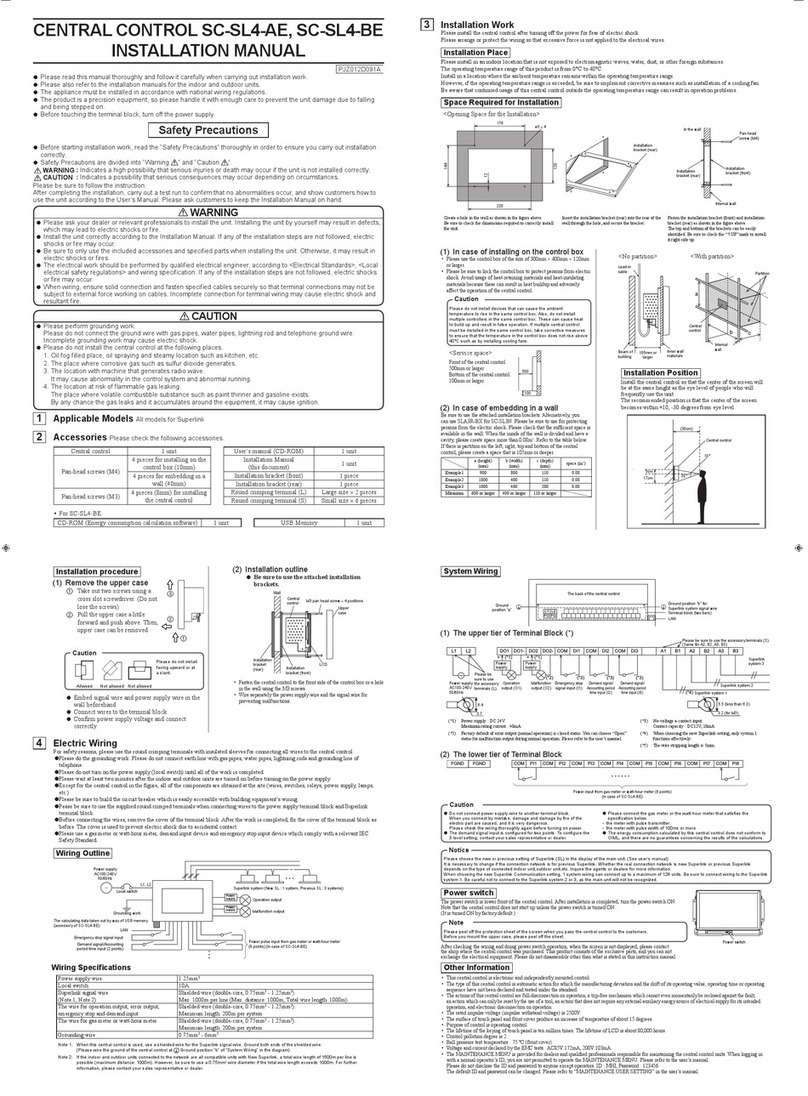
Mitsubishi Heavy Industries
Mitsubishi Heavy Industries SC-SL4-AE installation manual
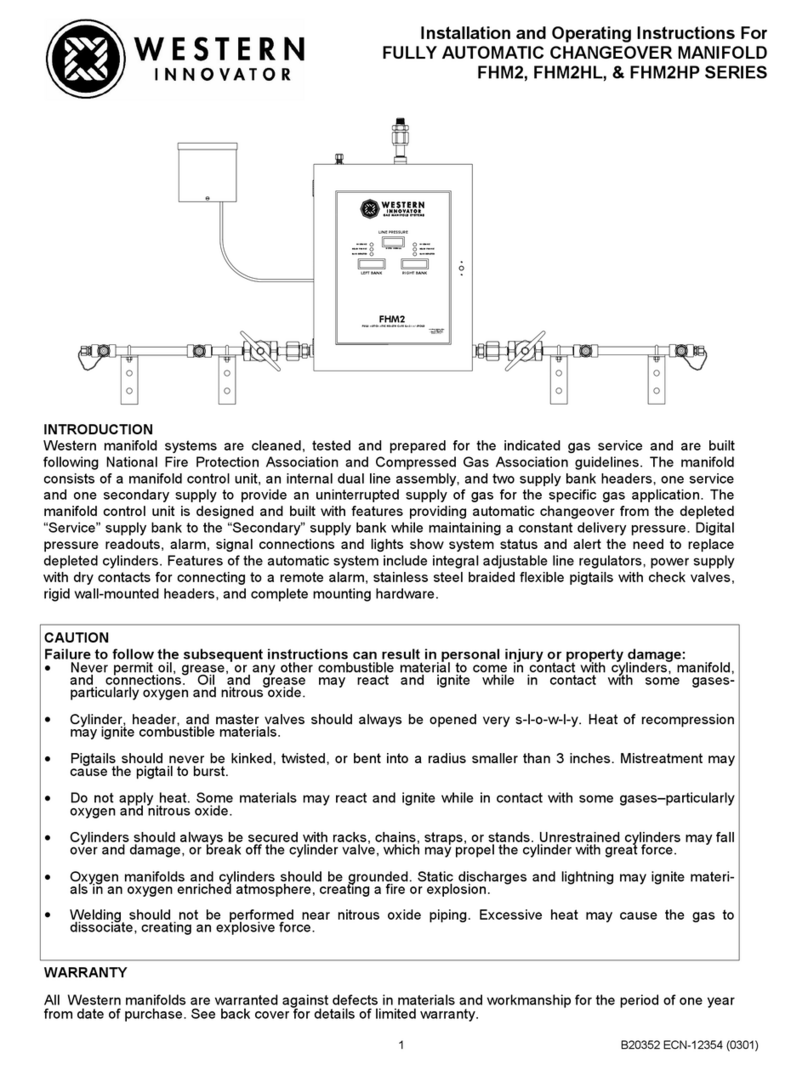
Western Innovator
Western Innovator FHM2 SERIES Installation and operating instructions
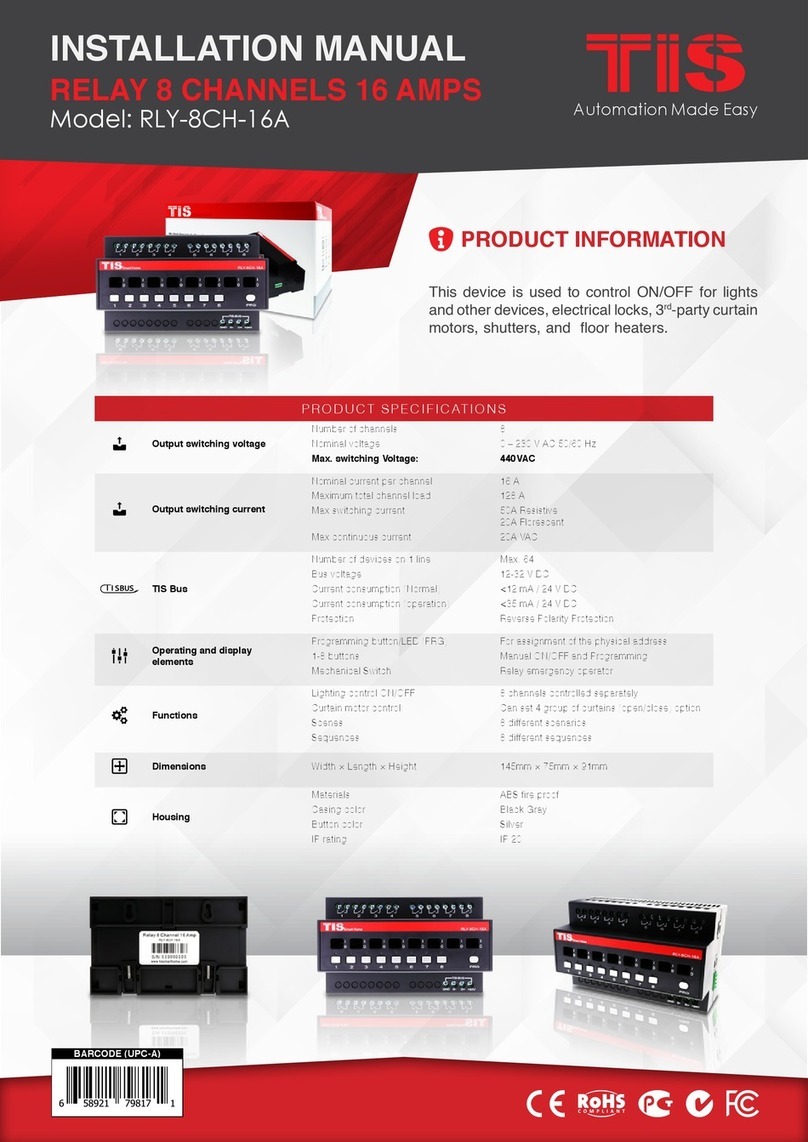
TIS
TIS RLY-8CH-16A installation manual
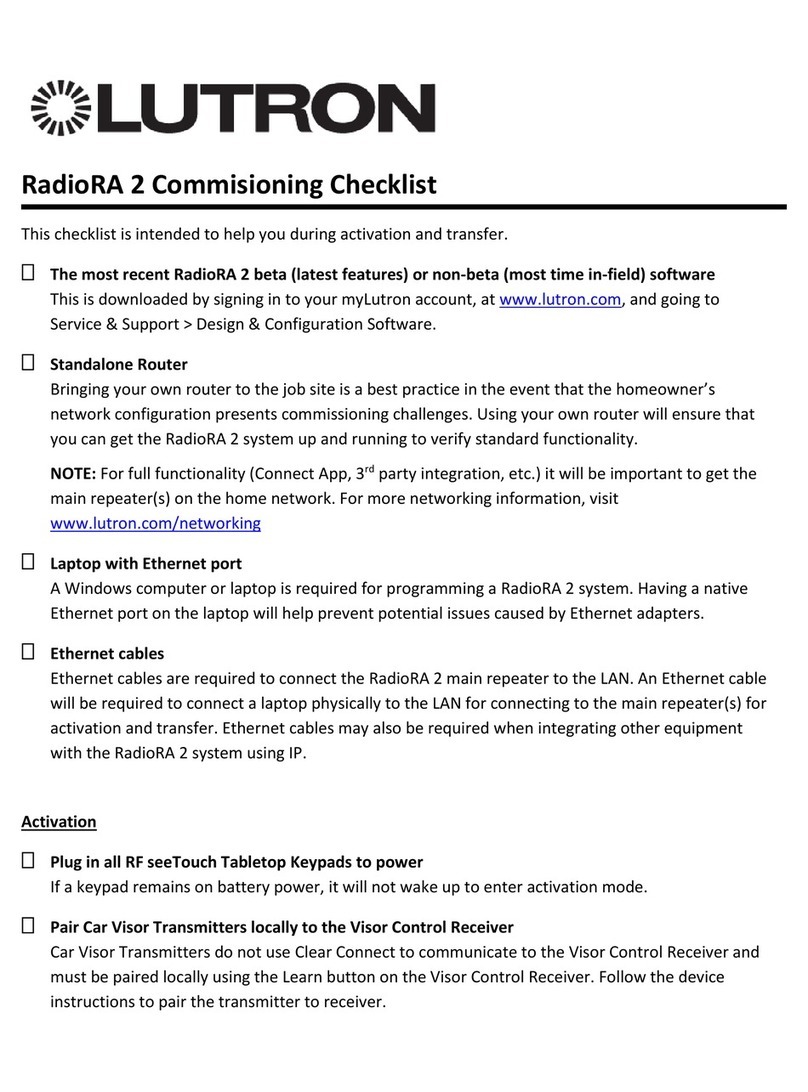
Lutron Electronics
Lutron Electronics RadioRA 2 Commisioning Checklist
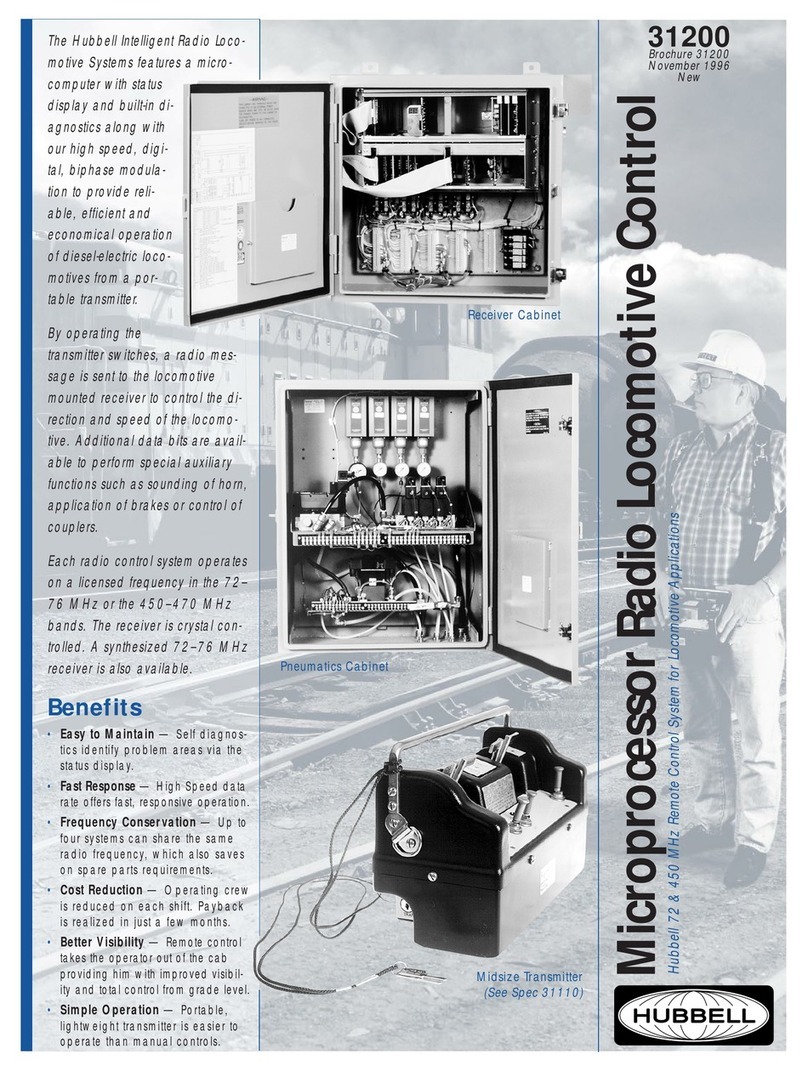
Hubbell
Hubbell Microprocessor Radio Locomotive Control... Brochure & specs
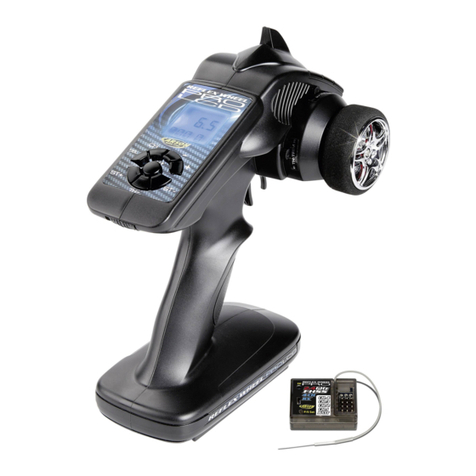
Carson
Carson Reflex Wheel Pro instruction manual
